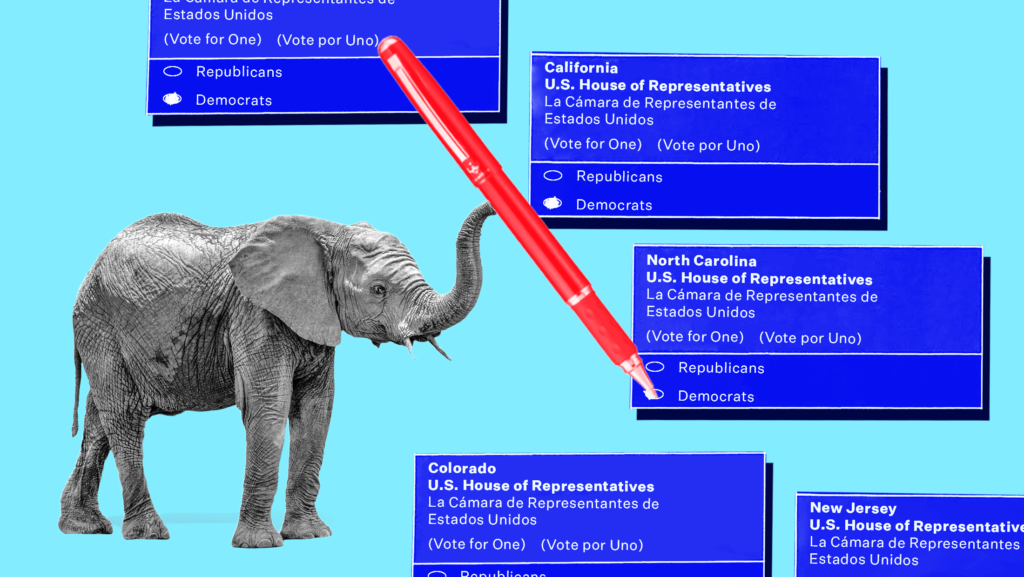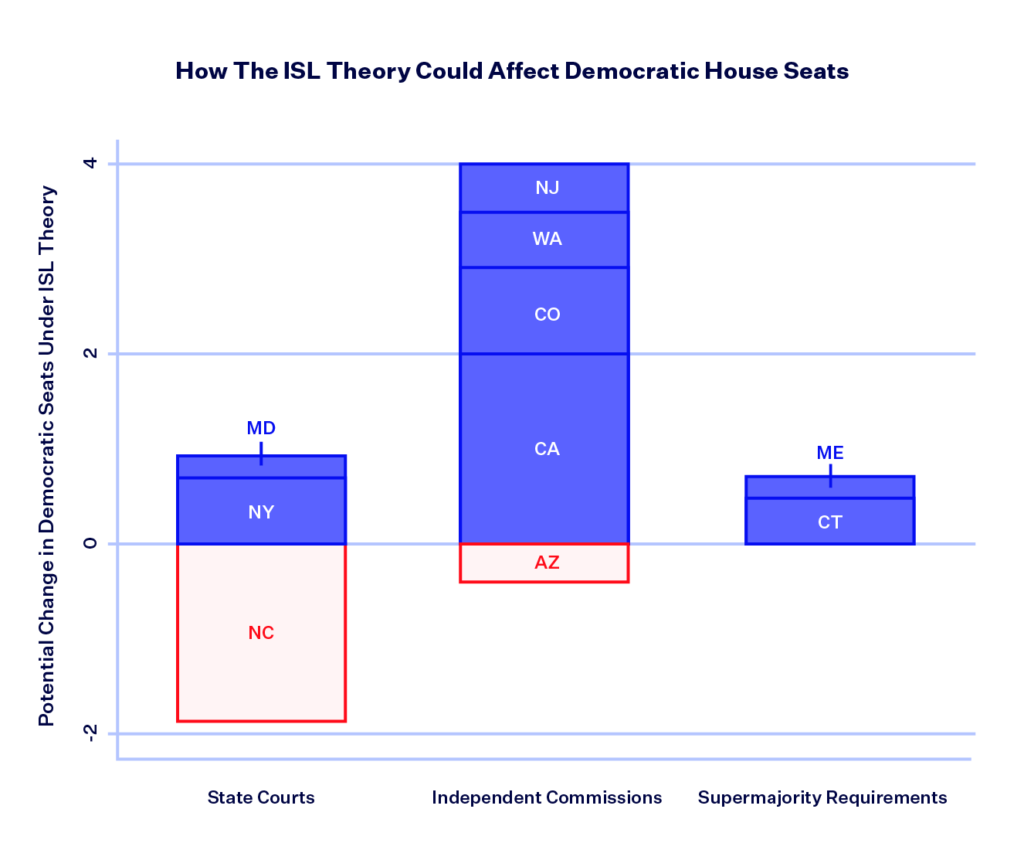The Partisan Implications of the ISL Theory

Observers of the debate over the independent state legislature (ISL) theory would be forgiven for assuming that its adoption would benefit Republicans. In the U.S. Supreme Court’s pending ISL case, Moore v. Harper, it’s Republican politicians who argue that the North Carolina Legislature should be allowed to gerrymander in Republicans’ favor without any state constitutional constraints. A generation ago, Chief Justice William Rehnquist invoked the ISL theory in Bush v. Gore to explain why he thought Florida’s recount should be halted while George W. Bush was still in the lead. In 2015, Chief Justice John Roberts penned a dissent maintaining that the authority of the Republican-dominated Arizona Legislature was unlawfully infringed by the establishment of an independent redistricting commission. And in litigation concerning the 2020 election, only Republican–appointed justices referred favorably to the ISL theory, and only in suits brought by former President Donald Trump and his allies.
However, at least in the context presented by Moore — congressional redistricting — this assumption is too quick. Of course, in North Carolina itself, the adoption of the ISL theory could result in a fair map being replaced by a Republican gerrymander. But nationwide, North Carolina is more the exception than the rule. Overall, Democrats would modestly benefit from a holding that state legislatures’ ability to draw congressional districts can’t be limited by state courts, independent commissions, or supermajority requirements. To be clear, these partisan effects in no way vindicate the ISL theory. It remains a pernicious claim unsupported by history or precedent that could transfer power to some of the institutions — state legislatures — least deserving of it. Nevertheless, given the Court’s interest in the ISL theory, its partisan implications are well worth investigating.
The first step is to determine which states could be affected by a ruling in favor of the petitioners in Moore. This is easier said than done since no such ruling has yet been issued. Still, it’s likely that states in the same position as North Carolina — with congressional plans originally designed by a single party that were then struck down by state courts on state constitutional grounds — would be impacted. This category also includes Maryland, New York and Ohio. It’s likely, too, that any ruling in favor of the Moore petitioners would reverse the 2015 Arizona decision and invalidate independent commissions responsible for congressional redistricting. If state legislatures’ mapmaking authority can’t be curbed by courts, it can’t be curbed by commissions either. Arizona, California, Colorado, Idaho, Iowa, Montana, New Jersey, and Washington all currently have unified Democratic or Republican governments that could freely gerrymander if the states’ commissions were nullified.
Additionally, judicial recognition of the ISL theory would probably doom supermajority requirements for enacting congressional plans. These requirements also amount to state constitutional restrictions on the ability of state legislatures to craft congressional districts as they see fit. At present, Connecticut and Maine have unified Democratic governments bound by supermajority redistricting thresholds. Lastly, one could argue that gubernatorial vetoes of congressional maps would also violate the ISL theory. But this position was rejected by the Court in a 1932 decision that no one, to my knowledge, now says should be revisited. So I don’t further consider the possibility that Moore would enable state legislatures to sideline adverse governors.
The second step of the analysis is to forecast what could happen in the fourteen potentially affected states if state courts, independent commissions, and supermajority requirements were all excised from congressional redistricting. In other words, what kinds of plans could we see if state legislatures could gerrymander at will in these states? A cautious way to make these predictions is to consult the sets of randomly generated congressional maps that Harvard University’s ALARM Project generously makes available. Unlike gerrymanders, these maps are created without considering partisan data. But the most pro-Democratic or pro-Republican map in a given simulation set is a reasonable approximation of how a plan that was shaped using partisan data — a gerrymander — would perform.
Finally, the hypothetical Democratic or Republican gerrymander for each potentially affected state simply has to be compared to the enacted plan to estimate the impact of the ISL theory’s adoption. For instance, the most pro-Republican map in the ALARM Project’s North Carolina simulation set is expected to yield 5.0 Democratic seats (out of 14). In contrast, the enacted North Carolina plan is expected to yield 6.9 Democratic seats. This means a ruling in favor of the Moore petitioners might enable North Carolina Republicans to increase their seat tally by about two. Similarly, the most pro-Democratic map in the ALARM Project’s California simulation set has 46.5 Democratic seats (out of 52) while the enacted California plan has 44.5 Democratic seats. If Moore ended the experiment of independent commissions, then, California Democrats might be able to win around two more seats.
The fact that Moore wouldn’t produce a redistricting bonanza for Republicans — and could actually do close to the opposite — is no basis for complacency.
The California example shows that Republican gains due to the ISL theory’s adoption could be counterbalanced by additional Democratic seats elsewhere. In fact, aggregating across all fourteen potentially affected states, Republican gains would be more than offset by extra Democratic seats. There’s only one state other than North Carolina where Republicans could benefit from a ruling for the Moore petitioners: Arizona, where a Republican gerrymander might have 0.4 more Republican seats than the enacted congressional plan. However, there are seven states beyond California where Democrats could be advantaged by a holding that state legislatures can gerrymander to their heart’s content: Colorado (0.9 more Democratic seats), New York (0.7), Washington (0.6), Connecticut (0.5), New Jersey (0.5), Maine (0.2) and Maryland (0.2). Summing these figures, Republicans could add roughly 2.3 seats from the ISL theory’s adoption while Democrats could tally about 5.6 seats more. The chart below displays these results graphically.

The chart also breaks down the results by the type of constraint that now binds state legislatures. In states like North Carolina, where state courts are the check, Republicans could gain a net of 1.0 seats from a ruling for the Moore petitioners. In states like California, where independent commissions are the reason why state legislatures can’t gerrymander, Democrats could gain a net of 3.6 seats from such a ruling. And in states like Connecticut, where the limit is a supermajority requirement, Democrats could gain a net of 0.7 seats. The dissolution of independent commissions is thus the main driver of Moore’s potential partisan consequences.
To reiterate, this discussion doesn’t take into account the impact of the ISL theory’s adoption outside the congressional redistricting context. That impact could be highly invidious. State legislatures could be able to suppress and subvert congressional votes free of state legal impediments. State legislatures could be able to wreak similar havoc in presidential elections. So the fact that Moore wouldn’t produce a redistricting bonanza for Republicans — and could actually do close to the opposite — is no basis for complacency. It’s just useful information to keep in mind as the debate over the ISL theory continues to unfold.
Nicholas Stephanopoulos is a professor of law at Harvard Law School and an expert on election law and constitutional law.